Registered with the Registrar of Newspapers for India under R.N.I 53640/91
Vol. XXVIII No. 18, January 1-15, 2019
Lost Landmarks of Chennai
Cowshed sabha of VM Street

The Music Season would have wound down by the time this story appears in print, but it is still a tale worth recounting. Today, a Sabha to us is invariably a formal auditorium, with proper seating, a stage, a sound system (whatever be its merits), and in most cases, an air-conditioned interior. But this was not the way Carnatic Music was heard in the past. In the old days, much of the music was in open-air locations – temples, pandals, parks; closed-door venues were school buildings. But even then, a concert in a cowshed was unusual and yet one flourished, in Triplicane.
In his Memoirs of a Mediocre Man, S.Y. Krishnaswami, ICS, writes of the Triplicane Sangeetha Sabha, which functioned from Venkatachala Mudali Street. The Valadi Brothers, owners of Valadi Stores in Triplicane, ran it. SYK noted that profit was the main motive and, “The premises was a cowshed of sorts, and cleaned for the occasion, not very scrupulously. Everyone sat on the floor, and as the concert proceeded, the first and second class members got mixed up and the dividing rope did a disappearing trick.” It was in these uncongenial surroundings that SYK first heard legends such as Palladam Sanjeeva Rao, Veena Seshanna and the Harikatha exponent Panchapakesa Sastrigal who, in SYK’s view, was “unmatched for erudition, wit, and the short and sweet musical interludes. He had a special affinity for the raga Senjurutti and his rendering of Ramayana slokas in that raga was an exquisite experience of word-tune-emotion unity.”
This was also where C Saraswati Bai, the first non-Devadasi woman to take to public performances, gave many Kathakalakshepam recitals. SYK makes note of this in his memoirs – “and Saraswati Bai, who was at one time the rage of rasikas, not merely because she was a good artist, but also because she was a woman, and her performances were attended by many old gentlemen who pretended to be interested only in the art.”
But that was not all. During “season,” which then did not mean December but sometime in July, just after the High Court reopened post-summer, the Valadi Brothers arranged special concerts at the historic Gokhale Hall on Armenian Street. They featured “eminent artists with eminent accompanists, the artists being Chembai, Nayana Pillay and Sanjeeva Rao, and the accompanists Govindaswamy Pillay on the violin, Alaganambi on the mridangam, Dakshinamurthy Pillay on the kanjira, Umayalpuram Sundaram Iyer on the ghatam and now and then Seetharama Iyer on the mohrsing.” All very laudable indeed but a further reading of SYK gives us some interesting details about the Valadi Brothers’ modus operandi.
The duo “always sold more tickets than the Hall could accommodate and quietly disappeared before the concert began. There was serious in-fighting among the audience for sitting space, but when the artists emerged from the tuning chamber, somehow order came to be restored and when the concert commenced, there was a hushed expectation, which was always rewarded.” It was at Gokhale Hall that the brothers introduced Chembai Vaidyanatha Bhagavatar to Madras audiences. This was a time when the powerful trio of Malaikottai Govindaswami Pillai (violin), Kumbhakonam Azhagianambi Pillai (mridangam) and Pudukottai Dakshinamurthy Pillai (kanjira) had fallen out with their regular singer – Kanchipuram Naina Pillai. They then decided to prop up Chembai, a young and upcoming artist. The Valadi Brothers printed handbills and drummed up enough interest for a record attendance at Gokhale Hall. On the day of the concert they did their usual disappearing act. Most members of the audience could not get in, but fortunately Chembai’s voice could be heard in the street. The doors were thrown up, Armenian Street was blocked, and the audience heard him spellbound. A new star was born.
It was however at the cowshed that the Brothers conducted much of their regular concerts. Several years later, R Venkataramana Row, C Saraswati Bai’s nephew, recalled them with gratitude for the support they had given his aunt in her early years. The Valady Stores was into the selling of cloth – dhotis and sarees. It is not clear as to when the business came into existence and when it folded up. For that matter the date of demise of the Triplicane Sangeetha Sabha.
I went down Venkatachala Mudali (VM) Street, which is a long thoroughfare stretching from Triplicane to Mylapore in search of a possible cowshed in which the Triplicane Sangeetha Sabha could have functioned. I saw plenty of cows, especially in the Triplicane end of the street but there were no cowsheds. Old-timers directed me to a huge barn of a building at beginning of this street but that had just been demolished. Perhaps this was Triplicane Sangeetha Sabha, where amid haystacks and cattle, the greatest of artistes performed and an enthusiastic audience gathered to listen.

